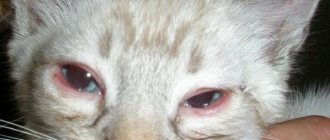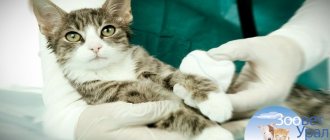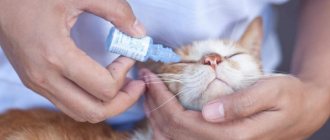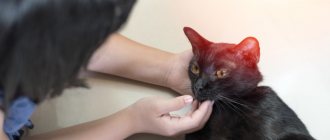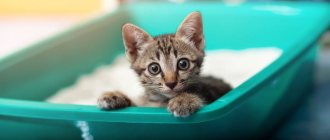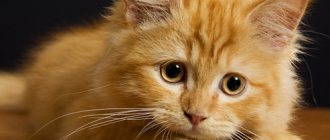Why do my kitten's eyes fester?
Suppuration in the eye area in kittens under 3 months of age is a fairly common problem. Moreover, this is not always associated with the influence of the external environment; most often, kittens are born with a problem that gets worse as the animal grows.
Why do a kitten's eyes fester?
- Chlamydia . Oddly enough, not only people, but also cats suffer from this disease. The disease is usually transmitted to kittens when passing through the mother's birth canal. A cat gives birth to her babies with chlamydia, which is why they have infectious conjunctivitis.
- Follicular conjunctivitis . Occurs when inflammation of the lymph nodes occurs. Along with discharge from the eyes, photophobia and swelling in the eyelid area will be observed. Please note that with this disease, hair around the eyes very often falls out.
- Purulent conjunctivitis . Most often it manifests itself in both eyes; with this disease, the cat experiences not only purulent discharge, but also an elevated temperature. Initially, the discharge from the eye area is very thin, but gradually becomes thick, with a green or yellow tint.
Purulent eye
How to distinguish dangerous lacrimation from non-dangerous ones
With pathological
When your cat has watery eyes, problems appear in one or both eyes. The discharge is thin or mucous, brown or slightly whitish.
The nature of the discharge can vary from liquid and transparent to thick, purulent. Typically, pathological lacrimation is accompanied by the animal's anxiety and itching: the cat constantly washes itself and rubs its eyes with its paws.
Body temperature may rise, red eyes, and swelling of the eyelids may appear. Crusts form in the corners of the eyes and hair falls out. When only one eye is watery, the cat squints it and rubs it with its paw. Pathological lacrimation may be accompanied by lethargy of the pet, poor appetite and other signs of illness.
With a sick animal, you should go to the veterinarian to get advice, understand the causes of the disease and take all necessary measures. Timely treatment will help avoid dangerous complications such as infection and blindness.
Tearing in cats can also occur due to
natural
causes. For example, after sleep one eye waters and does not open. This is not dangerous: the eye should be rinsed with boiled water or chamomile decoction.
Long-haired cats often have excessive tearing due to hair getting into the tear duct and the accompanying irritation. Breeders are advised to trim the long hair on the face of a long-haired cat and brush the pet regularly.
Due to the anatomical features of the structure of the skull and the short nasolacrimal ducts in the British, Scots and Persians, lacrimation is a normal variant. These cats cry almost constantly without experiencing any discomfort. Breeders of such cats need to take good care of their pet’s hygiene and periodically treat their eyes and face.
The kitten is a month old, its eyes are festering: reasons
With blepharitis, the eyelids become inflamed. This occurs due to exposure to an allergen, burn, or contact with harmful chemicals. Blepharitis occurs when a kitten is infected with worms, or with seborrhea. Often occurs due to vitamin deficiency.
Kitten is one month old, eyes are festering, reasons:
- Lesion in the eyelid area . This happens if the baby has a conflict with his brothers and sisters, or other animals with whom he lives. Perhaps you didn’t notice when the cats got into a fight and one scratched the other’s eye.
- Foreign object in the eyelid area . Just like in humans, when particles or food particles come into contact, the eyelids become swollen and the eyes turn sour. It is necessary to remove the foreign object from the eye.
- Violation of temperature standards in the room . In a draft, the kitten may catch a cold.
- Viral diseases. This often happens to homeless and domestic cats. A doctor will help you deal with such ailments.
Conjunctivitis
The kitten has snot and festering eyes - reasons: how to treat?
Calcivirus (calcivirosis) is a dangerous viral disease that affects approximately 30% of cats. It is not necessary that the cat be an outdoor cat. The virus can often be carried on clothing or on unwashed hands. The virus can survive on clothes and shoes for about one to two weeks without being introduced into the animal’s body. Therefore, the owner can bring illness from the street. Calcivirus is not dangerous for people, but about a third of cats die from this viral disease and the complications it causes.
Calcivirosis is manifested by the following symptoms:
- Runny nose and sneezing for one to two days.
- Heavy discharge from the eyes. They appear around the third day. The cat's appetite worsens, it may refuse to eat, and its body temperature rises.
- Around the seventh day, small ulcers and stomatitis may appear in the mouth.
The kitten has snot and festering eyes, how to treat:
- Treatment of calcivirosis is antiviral. The animal is given immunomodulators, and concomitant infections that are caused by weakening of the body as a result of exposure to the virus are also treated.
- Very often, cats die from bacterial complications that arise from the virus. Among them are pneumonia, arthritis, arthrosis, dehydration, and kidney failure. These ailments are caused by a virus and its untimely treatment.
- Rashes in the mouth are treated with antiseptics, lubricated with Lugol, and washed with furatsilin solution. Cats are vaccinated against such diseases at a young age. If the cat is outdoors, then the virus can enter the body, because it is transmitted from mother to child.
Conjunctivitis
Kittens' eyes fester and stick together: treatment with traditional methods
There are many ways to cure eye infection in a kitten. The treatment method depends on the original cause. When using the same medications for different ailments, treatment may be ineffective. The easiest way for such purposes is to use neutral agents that will help remove mucus, suppuration, and alleviate the kitten’s condition.
Kittens' eyes fester and stick together, treatment with traditional methods:
- Tea. It is necessary to brew strong tea, without adding fruit, moisten a gauze swab and apply it to the sore eye for a couple of minutes. Wait until the solids are completely dissolved in the tea.
- After this, you need to wipe with a swab from the outer corner of the eye to the inner. After this, you need to take new tampons. New swabs must be used for each eye.
- Chamomile tincture. For these purposes, you need to brew chamomile in the amount of 1 tablespoon of the herb per glass of boiling water. Keep it on low heat for 2 minutes. After this, you need to cool the mixture to a temperature of 20 degrees, moisten a gauze swab or cotton pad in the solution. In the same way, you need to hold it on the kitten’s eyelid for 2 minutes and rub from the outer corner of the eye to the inner one.
Treatment
General rules and recommendations for eye treatment and eye drops
Veterinarians' advice on this matter is always the same. Since the kitten will definitely not like such manipulations, it is necessary to carry out the procedure quickly, without distraction. Additionally, the following rules are observed.
- Before starting the procedure, the owner should wash their hands well with soap to avoid introducing additional infection and dirt into the kitten’s eyes.
Before procedures, wash your hands with soap
- It is better to carry out processing in pairs. One owner should place the pet on its back, placing it most comfortably on its lap. At the same time, it is important to secure the cat’s paws well so that he does not cause additional injuries to himself.
- The pet should lie down so that its head is higher than the rest of the body.
- The maximum temperature of the solution for washing and instillation should not exceed +37 degrees, otherwise the mucous membrane will be severely burned, which can lead to complete loss of vision.
- The bottle with the drug and the pipette are kept at a distance of at least 1 cm from the eyeball. If necessary, you can instill the medication using a sterile syringe without a needle.
- If the kitten's eyelids are very stuck together, you need to first squeeze a small amount of medicine onto them. After waiting a little, the mucus is removed using a clean swab. As soon as the eyes are opened, eye drops are instilled.
- When opening stuck eyelids, movements after using the medicine must be carried out from the bridge of the nose to the temples. Do not press hard or rub the sore spot, this will only increase irritation and cause pain to your pet.
- After opening the eyes, it is recommended to wipe them again with a dry swab to dry the fur a little.
We wipe the kitten's eyes with a cotton swab
- Under no circumstances touch the mucous membrane of your pet's eye with dry objects, they remove the top layer of corneal cells, provoke inflammation and cause severe pain. In addition, lint from a dry swab can remain on the eye, increasing unpleasant symptoms.
- Also, you should not touch the surface of the eye with your hands; any debris is removed with a wet swab with light blotting movements.
Video - Treating a cat's eye
Attention! To achieve maximum effect, veterinarians advise bringing the lower and upper eyelids together after using eye drops. This is required for complete distribution of the drug throughout the mucosa.
The kitten's eyes are festering - what should I wash it with?
To wipe the eyes, you can use not only decoctions of medicinal herbs, but also pharmaceutical preparations, which are widely used in surgery and in the treatment of wounds of various origins.
The kitten's eyes are festering, what to wash with:
- Furacilin solution. To prepare the product, you need to dissolve two tablets in 250 ml of hot water and heat almost to a boil, with constant stirring. It is necessary that the tablets dissolve completely. Cool the product to room temperature, soak a cotton pad in it, and wipe the cat’s eyes.
- Potassium permanganate solution. Please note that the liquid should be slightly pink, meaning the solution should be weak. Under no circumstances should a strong solution be used, as it can cause burns to the mucous membrane. A couple of crystals per glass of warm boiled water is enough. In the same way, you need to soak a cotton pad in the resulting solution and wipe your eyes.
- To treat the eyes, you can use ready-made solutions. Among them are Chlorhexidine, Miramistin, Decasan . These solutions are created without the use of alcohol, so they do not cause burns to the mucous membranes or discomfort during treatment. Ready-made products can be purchased at the pharmacy. Choose a solution that is suitable for treating mucous membranes. For example, for Chlorhexidine this is a 0.05% solution. It is necessary to soak a piece of gauze with the product and wipe the kitten’s eyelids from the outer corner of the eye to the inner one. Treatment with such antiseptics is carried out 3 times a day. This removes suppuration and also reduces the kitten's anxiety. After all, suppuration and dry crusts cause discomfort and unpleasant sensations in the animal, so the cat can additionally infect the wound.
Rest
Eye wash: the main thing
- Treatment and rinsing are the main methods of first aid and prevention of secondary infection for any diseases of the eyes of a cat.
- It is important to take care of your cat's eyes, starting from a young age and throughout her life.
- There are a large number of available products that can be used to wipe the eyes of both a kitten and an adult animal: decoctions of chamomile, calendula, an aqueous solution of chlorhexidine 0.01%, a solution of furacillin 0.02%, cleaning lotions.
- When treating an animal's eyes, it is important to use strictly aqueous and low-concentrated solutions.
- A special approach to the cat during the eye washing procedure predetermines its further attitude to any other therapeutic measures. It depends on him whether her attitude will be positive or negative.
- There are anatomical features of a cat's eye that predispose it to frequent contamination - it is important to pay attention to this and prevent secondary infections by periodically treating the eyes and skin around them.
- A very small kitten can be wiped with a cotton swab; for older animals, you can use cotton pads/gauze swabs.
How to treat a kitten’s eyes if they fester?
To treat eye suppuration in kittens, ointment and drops are often used. It is worth noting that ointments are more effective, because due to their thick consistency they remain on the mucous membrane longer, thereby observing a long-lasting therapeutic effect.
How to treat a kitten’s eyes if they fester:
- Tetracycline ointment
- Erythromycin ointment
- Levomycetin
- Phloxal
- Sofradex
All these ointments are best purchased in small tubes with a thin spout. In order to treat a kitten's eyes, you need someone to help you. You need to fix the kitten's head, lift its upper eyelid and insert a thin sausage of ointment into the space between the eyeball and eyelid. If the kitten does not give in and strongly resists, then you can inject the ointment into the lower eyelid area.
Then, by blinking, the animal will independently spread all the ointment over the surface of the eyeball. Please note that these ointments will be ineffective in case of viral infection, since only antiviral agents are used in the treatment of such diseases. In order for ointments to work effectively, they must be used 2-3 times a day.
Kitty
When is eye rinsing necessary?
This manipulation is necessary in a number of cases: prevention of secondary infection in case of injury, routine treatment of a contaminated eye in an animal predisposed to contamination, when removing mechanical contaminants and drug residues during treatment of an eye or systemic infection. Let's consider this issue in more detail.
Eye diseases
Conjunctivitis
– inflammation of the mucous membrane of the eye, that is, the conjunctiva, caused by a viral or bacterial infection, allergic reaction, injury, etc. Manifested by swelling of the conjunctiva, redness, active discharge and soreness.
Blepharitis
– an eye disease that affects a cat's eyelids. The eyes look swollen, discharge accumulates around them and dries into crusts, and there is itching and restlessness on the part of the animal.
Glaucoma
– this is a disease that develops as a result of increased intraocular pressure, manifested by damage to the optic nerve and retina. The chronic course of the disease can cause optic nerve atrophy, that is, lifelong blindness. The main manifestations are an increase in the volume of the eyeball, clouding, lacrimation, redness, etc.
Keratitis
– disease of the cornea of the eye. This pathology can be caused either by injury or be secondary to another eye disease. It manifests itself as swelling, lacrimation, clouding of the cornea, and when complicated by a secondary infection – itching and pain.
Cataract
– a rare disease, typical mainly for older animals, which consists of clouding of the lens of the eye. This change can be caused by chronic diseases of the animal - diabetes, trauma, intoxication, metabolic disorders, genetic predisposition, etc. Visually, this condition is noticeable only in the later stages.
Turn of the century
- A fairly rare disease in cats. This is a congenital problem or acquired as a result of long-term inflammatory processes, which is manifested by improper placement of the eyelid and eyelash margin. Most often, it turns inward, thereby constantly injuring the surface of the eye. Visually, this pathology manifests itself very characteristically, but the first thing that owners most often pay attention to is redness, increased discharge from the eyes, and anxiety.
More details about each disease can be found in the article.
Injuries
Mechanical damage to the surface of the eye most often occurs in cats that are on their own or live in contact with other animals. Injuries are caused as a result of mutilation by sharp objects, in fights, falls and other unforeseen situations.
This pathology is manifested by general inflammatory signs - discharge from the eye, swelling, anxiety on the part of the pet, pain. As a result, on the surface of the eye you can see swelling of the corneal tissue - a whitish surface. At the appointment, a doctor who suspects an eye injury conducts a fluorescein staining test. Thus, he details the extent and depth of the lesion - prognosis and further therapy depend on this.
Each disease is unique in its own way and requires an individual approach and prescription. But one thing remains common in treatment - in case of any inflammation, it is necessary to rinse the cat’s eyes and keep them clean. Before any manipulations, administration of drugs - drops or ointments, the owner must thoroughly treat the eye from mechanical impurities and secondary bacterial infections. In advanced diseases, the cat’s eyes have to be washed even to remove pus.
Anatomical features
Some cats have anatomical features of the nasolacrimal duct. For example, narrow, short, folded eye orbits, like exophthalmos, skin folds, occur in short-faced cats - Persians, exotics, Scottish folds. Owners of these cats often experience excessive tearing and tear tracks. Under the eyes of such cats, the secretion of the lacrimal gland often accumulates, in which, over time, harmful bacteria develop, causing a local inflammatory process, alopecia, itching and anxiety on the part of the animal.
It is important for such breeds to pay timely attention, treat and wash their eyes, ensure the prevention of bacterial inflammation, clean the skin and fur around them, without waiting for secondary changes.
The kitten's eye is closed and is festering - what should I use?
Drops can be used to treat eye suppuration in cats. It is worth noting that they are less effective than ointments due to their liquid state. With frequent blinking, they are washed out of the eyes along with tears and secretions. Below is a list of eye drops for suppuration in cats.
The kitten's eye has closed and is festering, what to apply:
- Lachrikan
- Lacrimin
- Tsiprovet
- Barrier
- Dexamethasone
It is necessary to treat suppuration of a cat’s eyes with drops for 2 weeks. Please note that they must be used according to the instructions, most often applied 3-5 times a day, 2 drops in each eye. You will also need the help of someone close to you to stabilize the cat's head and inject the medicine into the eye area.
The situation is more complicated if the cat has blepharitis or keratitis. These diseases must be treated under the supervision of a doctor with regular visits to the clinic. The fact is that infectious blepharitis, as well as keratitis, are often treated with antibiotics, not only local ones, but also those that are administered orally.
Most often these are injections, that is, injections. You may have to take your cat to the veterinary clinic for injections every day. If conservative treatment is ineffective, surgery is often prescribed to remove keratotic nodes, as well as suppuration in the eyelid area, for blepharitis.
Eyes fester
REMINDER before going to the veterinarian
- When did the tears first appear and when did they begin to bother the cat?
- Both eyes were affected at once or one after the other;
- What kind of discharge?
- What has the cat eaten over the past few days?
- When was the last time you had a vaccination, treatment or surgery;
- Are there any other symptoms?
Below we will discuss in more detail the possible causes of watery eyes in cats and the necessary treatment. IMPORTANT: Remember that only a veterinarian can make an accurate diagnosis after you have taken and waited for the tests. Therefore, if possible, do not delay going to the doctor.
A kitten's eyes are festering - prevention
Prevention is of great importance. Very often, cat owners are to blame for the fact that their pets suffer from conjunctivitis. The following rules must be followed to protect your cat from eye infections.
A kitten's eyes are festering - prevention:
- Pet your cat after washing your hands after visiting the street or toilet.
- Do not allow your pet to come into contact with stray animals. Visit your doctor regularly and get tested.
- Do not forget to give your animal vaccinations and also give anthelmintics twice a year. Very often the cause of suppuration is parasites.
- Bathe your animals with flea shampoo. Some pets may have an allergy to flea bites, which results in watery eyes.
- Keep chemicals and detergents used for cleaning the apartment away from the animal. Very often the cause of suppuration and inflammation of the eyes is contact with washing powder or dishwashing detergent.
- Introduce new food gradually, increasing the amount in the diet. Often, when introducing a new food, a pet may experience an allergy.
Kitty
Methods for preventing tears
- Do not neglect the rules of hygiene - bathe the animal once every few months, be sure to clean the ears and eyes once a week, brush the teeth every 2-3 days and comb the fur (if necessary);
- See your veterinarian regularly;
- Strengthen your cat’s immune system, as many diseases arise precisely because of low immunity;
- Try to make your animal’s diet as balanced as possible so that it receives all the necessary microelements;
- Don't forget to take your animal for a walk. In any case, this will have a beneficial effect on the body.
The kitten's eyes are festering: reviews
Please note that in order to choose the right treatment, you need to consult a doctor and read the reviews. Please note that an incorrectly selected remedy may not only not improve the condition, but also cause complications.
The kitten's eyes are festering, reviews:
Oksana. We have an ordinary yard kitten that we picked up from the street. After they brought it home, they discovered that the kitten had terrible sour eyes. We did not go to the veterinarian, we used Furacilin for washing, and smeared it with Tetracycline ointment. After about 2 weeks, the kitten completely recovered.
Maria. Our cat's eyes began to turn sour after a walk outside. Perhaps she caught an infection. We contacted the veterinarian and were prescribed Chlorhexidine rinsing and Floxal ointment. It turned out to be very effective, after about 7 days the eyes stopped turning sour, but we extended the treatment to 2 weeks.
Alexander. Kittens were born in our yard, but the cat does not live in the house, but lives on the street. After the babies opened their eyes, they became very sour. I felt sorry for the kittens, so I periodically rubbed my eyes with strong black tea and dripped cheap drops of Albucid. I myself know that these drops sting, but are effective. After a week, the cats’ health improved and their eyes stopped turning sour.
Sore eye
As you can see, sour eyes in cats is a common problem that can be caused by an allergy to food or injury. With timely diagnosis and treatment, the disease can be completely defeated.
